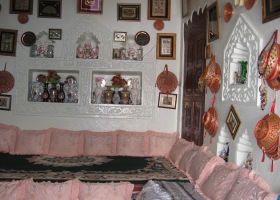
HARAR (1850m altitude)
Harar located in south Eastern Ethiopia about 526 kms from
Addis Ababa, has recently registered by UNESCO as World heritage site.
Harar
is among those cities in Africa that enjoy a mild climate throughout the year.
The well-known 19TH century traveler, Sir Richard Burton, who was the first European
visitor to enter what he called "forbidden city " left us a vivid memorable
ten days in Harar. In his own words " Harar is not hot, cool but not cold"
quoting a description of heaven-favored city, according to a Persian poet. He
also compares it with the climate of the Italian city of Tuscany. Butchlozer(101,1955)
a traveler who visited a century after Burton, has this to say about the natural
beauty of Harar; It doesn't matter you go there when the coffee bushes are in
flower and the air is heavy with their strong bitter scent, or when the ripe fruit
of the Orange trees glow in the sunlight, it is always lovely in Harar; there
is always something blooming, always being harvested.
At least seven settlements
are mentioned as the precursors of Harar according to a popular legend. These
were esshkanti gai (gai means "city" or "settlement").
Fereka gai, harawe gai. Hassen gai; Ruhuk gai; Sammti gai; and Tuhkungai. All
this sites are now awaiting archaeological excavation to tell their stories, except
Hasseb gai wich still keeps the name north Harar. These settlements resolved their
enmity and agreed to establish their center in Harar. This center had fertile
soil with abundant water to establish a sustainable agriculture system: it was
also a healthier location, being free from the common tropical diseases, such
as malaria, which are rampant in surrounding lowland.
There
are many legends related to the foundation of the city. However, shakih Abadir,
“the patron Saint" comes first when the name of Harar is mentioned.
He is said comes with his entourage in the tenth century from Arabia. It is believed
that he was the one who organized the administrative system of the city and also
gave Harar its name. With its numerous mosques and shrines, Harar is considered
the "fourth holy city of Islam" after Mecca, Mediana and Jerusalem.
Perched on a gentle hill, drained by network of rivers, Harar is an ancient walled
city. It was founded a millennium ago, between the seventh and ninth AD, by a
Semitic- speaking people.
The agricultural system of Harar was effective
and efficient. Using terracing and irrigation as well as intercropping which is
useful for tropical soil and a symbolically correct practice, the harar farmers
were able to produce grain and cash crops in adequate supplies for local consumption
and export. It is also considered as the original cultivation center of the world
famous coffee Arabica and the mild stimulant leaf called (cath edulis). Both are
lucrative export items, which provide the Ethiopian economy with substantial financial
resources.
Harar was not dependent exclusively on agriculture, but also
benefited from caravan trade, since it was geographically a half way house of
extensive trade between the
Red Sea, the Indian Ocean littoral and the vast
Ethiopian hinterland .To facilitate the international trade of those days; Harar
had to mint its own coinage. In the whole of Ethiopian Region, it was the second
center after Axum to produce coins since at least the Middle Age on. Harar also
played a role bridge between the old Akumite coins and the modern ones since the
first coins of Menlik were struck in Harar. This broad and stable economic base
helped Harar to become one of the leading center of learning in the horn of Africa
and to develop a unique urban culture uninterrupted through the centuries.
The shift of the capital city of the Adal State from Deker, an old settlement,
to the city of Harar in 1520 brought about the heyday of Harar. The new capital
becomes the springboard for Imam Ahmed Gragn, to incorporate to the Horn of Africa.
However, the leading role of Harar did not last long. After the wars of Gragn,
Harar was exposed to frequent attack from different sides. Nur, the nephew of
Imam Ahmed Gragn, built the remarkable defensive wall popularly known as jugal.
This wall warmly engulf the city which is confined within 48 hectares and 362
narrow lanes. The circumference of the wall 3,348 meters; with five traditional
gates.
These five gates demarcate the administrative as well as the socio-zones
of the old city. Jugal gives a sense of direction and belonging to Harar. This
wall, therefore, defines the major cultural texture of holistic fabric of the
Harar. Without it, the native feels as if the link with social and cultural environment
is missing. The social system is governed by gai a da the culture of Harar Communicated
through a unique language which is a mixture of Cushtic and Semitic languages
known as gai sinan, the language of the city. The hala mahal etiquette, of the
city is a binding force to enhance urban culture. After its heyday as the center
of the mighty Adal state, Harar gradually declined and become a small city- state
ruled by the dawoodi dynasty from 1647 to 1875. The occupying force of Egypt interrupted
the rule of the dynasty between 1875-1885. The closed gates to European travelers
were wide open during the Egyptians occupation. Rhmbaud, Paulischke (1888) and
many other came to Harar. The last Amir, Abudullahi, took over the mantle power
for less than 2 years, but was defeated by Menelik at the Battle of Chelenqo in
1887.
Thereafter, Harar was incorporated into greater Ethiopia, which was
then in the process of formation. Although it lost its independence, Harar remained
one of the most important economic emporia of the new empire ofthe new empire
of Emperor
Menelik. The occupation of Harar is considered one of the major
turning point for the success of Menelik against his rival powers, both internal
and external. In fact, "it would be impossible to write the history of Modern
Ethiopia without reference to Harar".
Addis Ababa, the present capital of Ethiopia, which was established
at the time of the Battle of Chelenqo, benefited from Harar experience. Surveyors,
masons, bookkeeper, peace keepers called yaradda zebegn, tailors and similar professionals
who were beckoned to Addis Ababa, contributed and disseminated their skills in
the building of the national preparation of the famous Battle of Adawa of 1896.
Just before the coming of the Italian Fascist invasion and occupation of the 193,
two journalist, Waugh [1934] and Frago[1935] visited Harar. Both of them were
impressed with cultural life of the city. Cerulli [1936 and 1971] who was first
class
Italian scholar of Semitic studies joined the invading army and administered
Harar for sometimes. His books are still the best reference work on the history
of city. As the result of the invasion, Harar expanded greatly and is now quite
often referred to as "the great Harar." The Italian destroyed the northern
farmland and established their administration headquarters called Butega without
affecting the old walled city. Within a walking distance one can easily transcend
space and time to pass from a medieval pre-industrial realty to modern city. The
old city, with its traditional rectangular stone house, winding narrow lanes,
abundance of mosques and shrines as land marks, perpetually enchants its visitors
as well as its residents; in contrast, the modern quarter is characterized by
wide asphalt roads and concrete buildings.
Currently, Harar is one of the
nine national of states of Federal State, encompasses about 400 sq. Km. With a
population of more than 120, 000 is ready to encounter the twenty first-century
with self assured strides to fulfill its responsibility of integrated development
in all sphere of life. The age old metropolitan Harar has already achieved impressive
results in various fields of activities. This old city which claims more than
a millennium of history is happy to share its mystic knowledge and is ready to
learn from others.
Moving from a macro to micro view of the city reveals
an abundance of aesthetic traditions that echo this beauty. Many compound had
courtyard with green plants, pots, benches and that sense of peace and order in
a small space which is so often characteristic of traditional Islamic life according
to the observation of Henz. The Harari house reveals a sense of proportion and
mastery of building technology, perfected over the centuries, that is both warm
and inviting. Inside the house, on the walls of the living room, one is overwhelmed
by the balance and color composition of the display of baskets. The colorful dress
of Harari women is anther dimension of the aesthetic beauty that permeates Harari
life. Indeed, Harar the jewel of east, has earned many names; ‘Abadir,'
Medinet al Awlia's, ‘Jebel al Awlias', ‘ the fourth Muslim City',
‘The Timbukutu of the East" and many others. Still, it radiates as
a historical, cultural as well as social peg which should be reserved for posterity
without affecting new innovative trends. The maze narrow lanes and the unforgettable
colorful market scenes, added to the uniquely structured houses, give the city
the touch of a living museum. The recent conservation attempt is encouraging,
but it is not enough. In conclusion, this is a glimpse of the beauty of the walled
city. A mountain top view of Harar reveals a mosaic of diverse scenery. One sees
great natural beauty in contrast to the beauty of the human built environment.
The colors are remarkable. Outside the city walls the lush green foliage with
meandering steams reminds one of Persian carpets. The prolific writer on Ethiopian
affairs, Henze, compares this beauty with an illustration of medieval manuscript.
In contrast, inside the old wall the colors and shapes change, one sees primarily
whites and grays and diverse ranging of geometric shapes of varying sizes. The
hill on which the old city resists is a constantly changing organic form, shaped
and reshaped by the hands of masons for over a millennium.
Famous
of its ancient buildings, its great city walls and gates, narrow streets, mosques,
its colorful markets and it’s gaily clad women, its finely wrought filigree
silver handcrafted & basketry and Hyna man, Harar is of the highlights of
a visit to other Historical Ethiopia.
DIRE
DAWA (1162m altitude)
Dire Dawa is
55kms from Harar. Unlike Harer it has very different character, while Harar preaches
at the top, Dire Dawa lies at the foot of the escarpment & the climate is
considerably warmer and drier. Dire Dawa was founded very recently in 1900 as
a result of the advent of the railway, which reaches the point in 1902 and stayed
that way for some years before finally completing its journey to Addis Ababa.
It is one of the 2nd populous towns in Ethiopia with more than 100,000 inhabitants.
The old part of the town is made of twisting streets and Arab-Style houses with
Somali women in black velvet, their face covered with purple veils. The new quarter
presents quite a contrast, with its tree-shaded boulevards; trim modern houses,
factories and its new multistory hotels and a fine hospital.
These attractions
can be vested after on anticipation of Harar.

